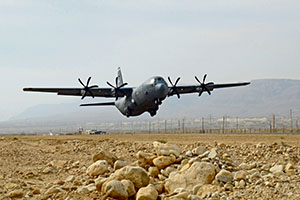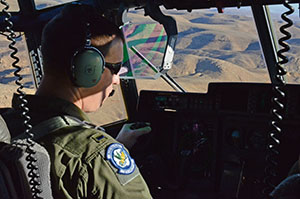NEVATIM AIR FORCE BASE, Israel — The 86th Airlift Wing and 435th Contingency Response Group conducted a flying training deployment with the Israeli air force’s 103rd Squadron Jan. 27 to Feb. 8 here.
The FTD advanced the ability of both American and Israeli air and ground crews to perform in combat operations, as well as strengthened partnerships between the two allies.

“The purpose of this training was to hone our tactical expertise while building partnerships and maximizing bilateral training,” said Capt. Raymond Bevivino, 37th Airlift Squadron pilot and FTD mission commander. “This opportunity allowed us to accomplish training that we just can’t get anywhere else.”
With minimal restrictions to altitude, air space and weather, the two-week deployment ensured many of the 37th AS pilots met training requirements that keep them proficient on combat airlift tactics.
“There’s a ton of stuff we have to get trained on, and I got 57 semiannual requirements accomplished in a four-hour flight,” said 1st Lt. Sean Jensen, 37th AS pilot.
More than five years have passed since the 86th AW and the 103rd Squadron have trained together. Since then, the 86th AW has transitioned from the C-130 E/H model to the newer, more advanced C-130J model. The IAF is scheduled to undergo the same transition this year.
“We flew with Israeli pilots who are going to be transitioning from their (C-130E/H) models to the new J’s. They flew with us and we talked about some of our different procedures and tactics and the way we employ the C-130J,” said Capt. Brett Polage, 37th AS pilot. “They talked about some of their tactics and how they train here in Israel, and we basically just compared notes.”
Sharing tactics with the IAF ensured the 37th AS pilots sharpened their skills as combat airlifters.
“Any time you teach something, you learn it better than you knew it before,” said Col. William Ward, 86th Operations Group commander. “It helps cement in our minds some of the differences … (to) emphasize the ways that we have to operate differently with fewer crew members while fully exploiting the technology.”
It wasn’t just the pilots who had the opportunity to teach their craft to the IAF; Airmen from the 86th Operations Support Squadron, 86th Aerospace Medicine Squadron, 86th Maintenance Squadron, 86th Aircraft Maintenance Squadron, 86th Logistics Readiness Squadron and 435th Air Mobility Squadron were also present for the FTD.

“I have each specialty with me … like hydraulics, like electricians, (communications), (navigation), avionics, (hydraulics) — each system,” said Master Sgt. Dana Aube, 86th AMXS productions superintendent. “(IAF members) come over and I have my experts from each system walk them through the differences of the E/H’s from the J’s.”
The maintainers worked days and nights to ensure two sorties of two C-130s went up nearly every day. The training is considered imperative to the readiness of the wing for contingency operations.
“They’re working hard at getting their combat training accomplished,” Ward said. “If we were to execute contingency operations in that area in the future … we will have the benefit of having flown in the air space.”







